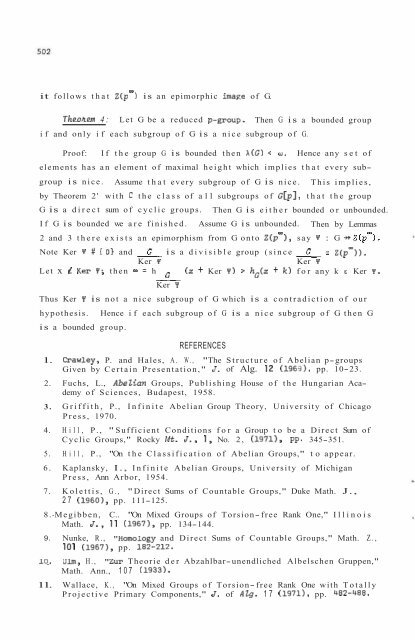Create successful ePaper yourself
Turn your PDF publications into a flip-book with our unique Google optimized e-Paper software.
mit follows that Z(p ) is an epimorphic imape of G.Theohem 4: Let G be a reduced p-group. Then G is a bounded groupif and only if each subgroup of G is a nice subgroup of G.Proof: If the group G is bounded then A(G) < lsi. Hence any set ofelements has an element of maximal height which implies that every sub-group is nice. Assume that every subgroup of G is nice. This implies,by Theorem 2' with C the class of all subgroups of ~[p], that the groupG is a direct sum of cyclic groups.Then G is either bounded or unbounded.If G is bounded we are finished. Assume G is unbounded. Then by Lemmasm2 and 3 there exists an epimorphism from G onto Z(p 1, say Y : G ->Ã z(pm).<strong>No</strong>te Ker Y # { 0) and is a divisible group (since z(pm)).Ker YKer YLet x i Ker Y; then - = h (x + Ker Y) > hG(x + k) for any k E Ker Y.-Ker YThus Ker Y is not a nice subgroup of G which is a contradiction of ourhypothesis.is a bounded group.Hence if each subgroup of G is a nice subgroup of G then GREFERENCES1. Crawley, P. and Hales, A. W., "The Structure of Abelian p-groupsGiven by Certain Presentation," J. of Alg. 12 (19641, pp. <strong>10</strong>-23.2. Fuchs, L., Abelian Groups, Publishing House of the Hungarian Academyof Sciences, Budapest, 1958.3. Griffith, P., Infinite Abelian Group Theory, University of ChicagoPress, 1970.4. Hill, P., "Sufficient Conditions for a Group to be a Direct Sum ofCyclic Groups," Rocky Mt. J., 1, <strong>No</strong>. 2, (1971), Pp. 345-351.5. Hill, P., "On the Classification of Abelian Groups," to appear.6. Kaplansky, I., Infinite Abelian Groups, University of MichiganPress, Ann Arbor, 1954.7. Kolettis, G., "Direct Sums of Countable Groups," Duke Math. J.,27 (19601, pp. 111-125.8.-Megibben, C.. "On Mixed Groups of Torsion-free Rank One," IllinoisMath. J. , 11 (1967), pp. 134-144.9. Nunke, R., "Homology and Direct Sums of Countable Groups," Math. Z.,<strong>10</strong>1 (1967), pp. 182-212.<strong>10</strong>.. Ulm, H., "Zur Theorie der Abzahlbar-unendliched Albelschen Gruppen,"Math. Ann., <strong>10</strong>7 (1933).11. Wallace, K., "On Mixed Groups of Torsion-free Rank One with TotallyProjective Primary Components," J. of Alg. 17 (1971), pp. 482-488.USE OF MATRICES IN THE FOUR COLOR PROBLEMby Ualuil tU.notiPoQte.cl~~c 11~tULu-te. of, NW YohkThe four color problem has fascinated mathematicians and laymen forhe pasr <strong>10</strong>0 years.<strong>No</strong>twithsranding rhe massive research in this areaand rhe rampanr growrh of graph ~heory, of which map coloring is a sub-field, he four color problem remains unsolved to the present day. Thereader may wish to consult Marshall [lland May [5] for a historical ac-count of the subject.The four color problem may be stated with the aid of the followingtwo definitions:Oef,.b%&ion 1: A finite collection h! = {R.} of closed subsets ofi.E^ having the propertiesand1) each R. has positive area,2) Ri n intR = $ foralli and j, i # j,33) each R. is a homeomorphic image of the unit circle,is called a map; the Rijqs are called regions.More refined definitions can be given using the concept of planargraphs; see Ore [3], Tutte's definition in Harary [4].Uef,i.fion 2: A wit-coloring of a map is a function assigningto each region R. e a color a suah that, for all j # in, if1- o io'3R n 3R is a set of positive measure then c # a1-0 3 io j'The central question is: Given a map M uhat is the minimum number, x,,,of colors which is required to well-color the map?Obviously, if themap has n regions, xM 5 n; however we can do much better than this.fact, as seen in Ore [6], for any map h!X\,( 5 .We may now ask: Is it possible that four colors are sufficient to well-color an arbitrary map h!?An obviously related question is: Can we con-struct a counterexample which cannot be well-colored with four colors?In
















